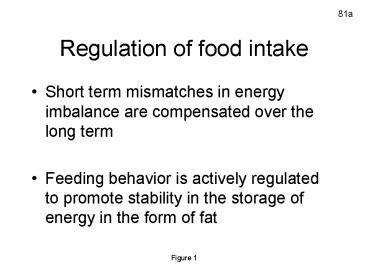Regulation of food intake - PowerPoint PPT Presentation
1 / 26
Title:
Regulation of food intake
Description:
... in leptin and the leptin receptor are extremely rare causes of obesity in humans ... Bilateral PVN lesions cause a hyperphagic obesity syndrome ... – PowerPoint PPT presentation
Number of Views:177
Avg rating:3.0/5.0
Title: Regulation of food intake
1
Regulation of food intake
81a
- Short term mismatches in energy imbalance are
compensated over the long term - Feeding behavior is actively regulated to promote
stability in the storage of energy in the form of
fat
Figure 1
2
Feedback control systems
81b
- Two negative feedback control systems
- Inhibition of food uptake in proportion to
adipose tissue mass (controls feeding behavior
over time scales of days to weeks). Major
mediators are insulin and leptin. - Inhibition of feeding behavior at the level of
individual meals by controlling the onset of
satiety. Satiety factors include peptides and
nervous signals initiated in the GI tract
Figure 2
3
Insulin and feeding behavior
81c
- Increased fat stores induce a state of insulin
resistance - Compensatory responses by the pancreas result in
increased circulating insulin in order to
maintain glucose homeostasis - Increased insulin in the CNS inhibits food intake
Figure 3
4
81d
Ob/Ob mouse
Ob/Ob mouse treated with leptin
Figure 4
5
Leptin (from leptos-thin)
82a
- Secreted directly by adipose tissue (serum
concentrations roughly proportional to fat mass) - Acts in the central nervous system to suppress
food intake. - Deficiency results in massive obesity (leptin
gene positionally cloned from the Ob/Ob mouse)
Figure 5
6
82b
Figure 6
7
Case Report
82c
- Normal birth weight, morbid obesity beginning in
infancy - Marked hyperphagia
- Severe hyperinsulinemia
- At age 4, weight was 41 kg (90 lbs) and percent
body - fat was 57 (normal 20)
- Highly consanguineous pedigree
Figure 7
8
82d
Figure 8
9
Leptin Replacement Leads to a Drastic Reduction
in Obesity
83a
6
72 lbs.
4 2
35.5
46 pmol/l
Test Meal
1138 Cal.
145 Cal.
Figure 9
Farooqi et al., 2002, J Clin Invest, 2002
10
83b
Figure 10
11
Leptin signaling
83c
- Leptin signaling in the brain is initiated by its
interactions with the product of the db gene,
which encodes the leptin receptor - db mice are also massively obese, and have
markedly elevated levels of circulating leptin. - The leptin receptor regulates gene expression by
activating JAK kinases that control the actions
of STAT transcription factors
Figure 11
12
Leptin signaling
83d
- Mutations in leptin and the leptin receptor are
extremely rare causes of obesity in humans - Resistance to leptin signaling is common in obese
patients and in many obese strains of mice that
do not have ob or db mutations.
Figure 12
13
Hypothalamic targets of leptin and insulin
84a
- Anabolic peptides that are subject to negative
regulation by leptin and insulin - Neuropeptide Y (NPY)
- Agouti-related polypeptide (AGRP)
Figure 13
14
Catabolic effectors - positively regulated by
adiposity signals
84b
- Melanocortins (e.g., a-melanocyte stimulating
hormone a-MSH) - Corticotropin releasing hormone (CRH)
- Thyrotropin releasing hormone (TRH)
- Cocaine and amphetamine-regulated transcript
(CART) - Interleukin 1b
Figure 14
15
Neuroanatomical pathways
84c
- Arcuate nucleus
- NPY and AGRP are coexpressed in arcuate nucleus
neurons - Inhibited by leptin
- POMC and CART are coexpressed in adjacent but
distinct arcuate nucleus neurons - Activated by leptin
Figure 15
16
84d
Figure 16
17
Secondary neurons
85a
- Neurons in the arcuate nucleus that receive
inputs from adiposity signals regulate secondary
neurons that control feeding behavior and energy
homeostasis - Targets Paraventricular nucleus (PVN), zona
incerta, perifornical area (PFA) and LHA
Figure 17
18
Secondary neurons
85b
- Stimulation of PVN neurons inhibits food intake
- Bilateral PVN lesions cause a hyperphagic obesity
syndrome - Stimulation of the LHA and PFA stimulates food
intake. - Bilateral lesions of the LHA cause anorexia and
weight loss
Figure 18
19
85c
Stimulation inhibits food uptake
Stimulation enhances food uptake
Figure 19
20
85d
Figure 20
21
86a
POMC neuron
Figure 21
22
87b
ADIPOSE TISSUE
WEIGHT GAIN
WEIGHT LOSS
Leptin
Leptin
Hypothalamus
Hypothalamus
Response to Starvation
Response to Obesity
Immune Function
Food Intake
Parasympathetic Tone
Food Intake
Insulin Action
GnRH
Energy Expenditure
CRH
Energy Expenditure
Lipid Content In tissues
GHRH
Temperature
SRIF
Adrenal Function
Reproductive Function
GH
Skeletal Growth
Figure 22
23
Satiety signals
86c
- Major determinant of meal size is onset of
satiety - Signals transmitted to the brain via afferent
fibers of the vagus nerve and by afferents
passing into the spinal chord from upper GI tract
and abdominal viscera - Integrated by the nucleus tract solitarius and
caudal brain stem
Figure 23
24
Mechanical and chemical satiety signals
86d
- Taste input from oral cavity
- Stretch receptors in stomach
- Energy metabolism in liver
- Humoral signals (e.g., cholecystekinin, released
upon nutrient stimulation of neuroendocrine cells
in intestinal lumen
Figure 24
25
Additional signaling molecules
87a
- Noradrenalin - injection into PVN increases food
intake. May contribute to anabolic effector
pathways - Seratonin system - cell bodies in caudal
brainstem that are primary targets of some
centrally acting obesity drugs (e.g.,
dexfenfluramine). Increased signaling supresses
appetite. - Dopamine - pharmacologic depletion results in
severe deficits in feeding behavior.
Figure 25
26
87b
Figure 26

